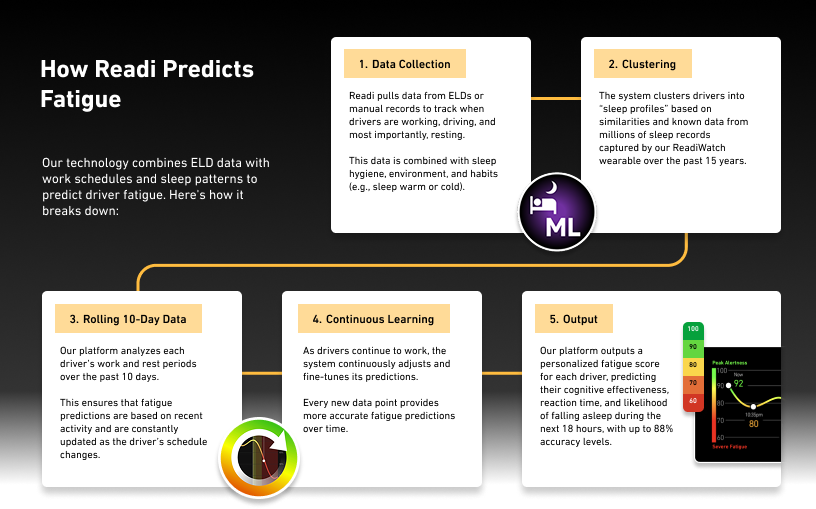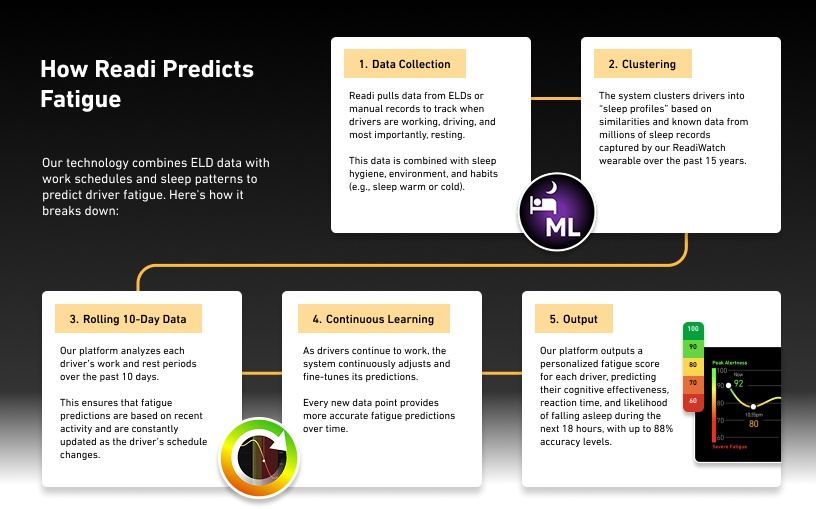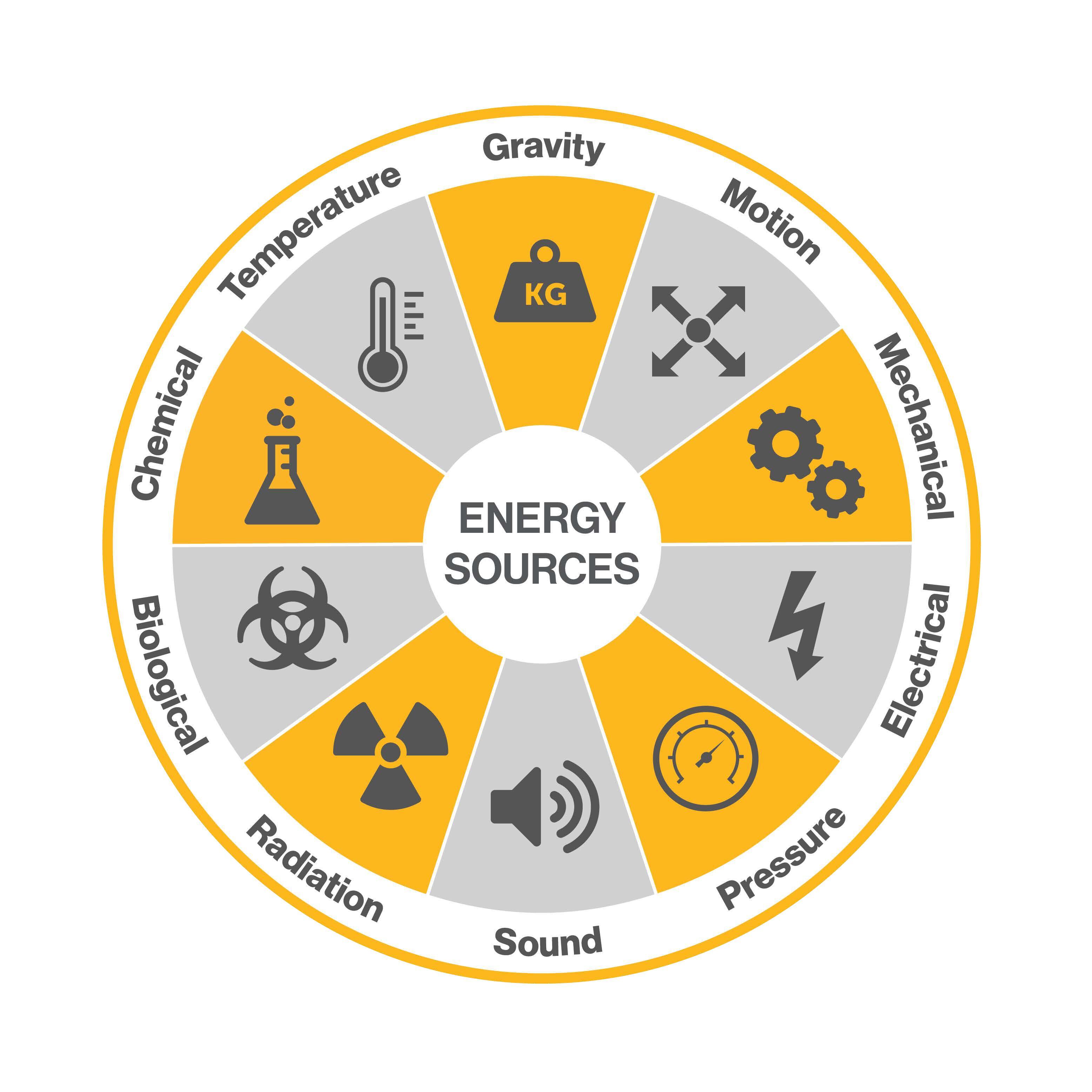Every year, drowsy driving causes approximately 91,000 police-reported crashes, resulting in 50,000 injuries and nearly 800 deaths across the United States. These sobering statistics represent just the tip of the iceberg—experts agree that fatigue-related incidents are significantly underreported due to the difficulty in determining drowsiness as a primary crash factor.
Book a demo to learn more about Readi, predictive fatigue management platform that uses AI and machine learning to detect individual operator fatigue risk up to 18 hours in advance.
The transportation industry faces unique challenges with driver fatigue, as commercial drivers often work extended shifts and navigate lengthy routes through the night. Studies indicate that 65% of mining haul truck accidents involve operator fatigue, while drivers who sleep less than four hours are 11.5 times more likely to crash than well-rested operators.
Modern technology now offers sophisticated solutions to combat this critical safety issue through advanced drowsy driving detection systems. These innovations have evolved far beyond simple alarms to provide comprehensive, predictive capabilities that can identify fatigue risks before they become life-threatening situations.
What Is Drowsy Driving Detection?
Drowsy driving detection refers to advanced technology systems designed to identify when you or your workers show signs of fatigue while operating vehicles. These sophisticated solutions go beyond traditional safety measures by actively monitoring driver behavior and physiological indicators in real-time, providing crucial warnings before fatigue reaches dangerous levels.
These systems monitor various behavioral patterns, physiological indicators, and vehicle movements to detect drowsiness before it leads to dangerous situations. Modern detection technology analyzes multiple data streams simultaneously—from eye movement patterns and facial expressions to steering behavior and lane positioning. The comprehensive approach ensures accurate identification of fatigue across different stages, from early warning signs to critical drowsiness levels.
Unlike simple alerts or alarms, modern drowsiness detection systems use sophisticated algorithms to analyze multiple data points and provide real-time warnings. Today's solutions incorporate machine learning and artificial intelligence to understand individual driver patterns, environmental factors, and contextual information. This multi-layered analysis dramatically reduces false positives while maintaining high detection accuracy for genuine fatigue events.
The technology has evolved from basic steering pattern monitoring to comprehensive systems that can predict fatigue risk hours or even days in advance. Early systems relied solely on detecting lane departures or erratic steering movements—reactive measures that often triggered too late.
Current generation technology leverages decades of sleep science research, incorporating frameworks like the Karolinska Sleepiness Scale (KSS) and recommendations from organizations such as the National Highway Traffic Safety Administration (NHTSA) and European Union's General Safety Regulation II.
Advanced drowsiness detection now encompasses:
- Predictive Analytics: Systems that analyze work schedules, sleep patterns, and historical data to forecast individual fatigue risk up to 18 hours in advance (eg, Readi)
- Multi-Behavior Recognition: Technology capable of tracking 17+ different drowsiness indicators simultaneously, from micro-sleeps to gradual performance degradation
- Real-Time Processing: Immediate analysis and alerting capabilities that notify both drivers and supervisors within seconds of detection
- Contextual Awareness: Algorithms that adjust sensitivity based on time of day, route conditions, weather, and individual driver baselines
The integration of these capabilities creates a comprehensive safety net that addresses fatigue at multiple levels—from prevention through scheduling optimization to immediate intervention when drowsiness occurs. This evolution represents a fundamental shift in how organizations approach driver safety, moving from reactive incident management to proactive risk prevention.
How Drowsy Driving Detection Technology Works
Behavioral Monitoring Systems
Leading-edge systems use cameras to observe eye behavior, tracking movements and blinks to detect fatigue. Sophisticated algorithms assess facial cues—such as yawning and eye closure duration—to pinpoint drowsiness. These systems can identify brief lapses in consciousness, known as micro-sleeps. Immediate alerts are generated when signs of fatigue surpass safe levels, ensuring swift action.
Vehicle-Based Detection Methods
These methods analyze driving patterns, focusing on steering inputs and lane adherence. Systems detect minimal steering followed by abrupt corrections, classic signs of fatigue. Monitoring lane positions helps identify frequent drifting from the center. Variations in speed and delayed responses offer further insights into fatigue levels, creating a detailed alertness profile.
Physiological Measurement Technologies
Advanced setups incorporate heart rate and skin conductance sensors to detect subtle changes in alertness. Brain activity monitors can identify shifts before visible signs appear. These biological markers provide early warnings, integrating with wearable devices to extend monitoring beyond the vehicle.
AI- and Machine Learning-Based Technologies
AI and machine learning revolutionize fatigue detection through predictive algorithms. These systems harness electronic logging and attendance data, alongside driver questionnaires, without needing wearables. By adapting to individual patterns, they offer precise fatigue forecasts, supporting proactive management.

Which Type of Technology Is Better?
AI-driven fatigue monitoring excels through its predictive and adaptive capabilities. Solutions like Readi enhance fleet safety by forecasting fatigue risks, allowing timely interventions. This technology aligns work schedules with natural alertness cycles, offering significant safety and efficiency benefits.
Key Benefits of Implementing Drowsiness Detection Systems
Enhanced Safety Outcomes
Implementing drowsiness detection systems transforms safety protocols by providing early warnings of fatigue, allowing for timely interventions. This proactive approach helps protect your workforce and other road users, reducing the likelihood of fatigue-related incidents. By maintaining comprehensive safety records, you can demonstrate a robust commitment to employee safety and public welfare.
Operational Efficiency Improvements
These systems streamline operations by leveraging real-time data to refine shift schedules and minimize fatigue. Reduced downtime and enhanced productivity are achieved by identifying critical risk periods and optimizing route planning. The continuous feedback loop created by these insights supports the evolution of your safety strategies, ensuring productivity remains high.
Compliance and Risk Management
Drowsiness detection technology aligns with stringent safety regulations, offering peace of mind through reduced liability risks. By creating detailed audit trails, these systems facilitate thorough incident investigations and support insurance processes. The development of robust fatigue management policies is bolstered, reinforcing a culture of safety and compliance across your organization.
Types of Driver Alertness Monitoring Systems
In-Vehicle Hardware Solutions
In-vehicle hardware solutions employ a combination of advanced technologies to enhance driver safety. Dashboard-mounted cameras with infrared capabilities facilitate effective monitoring both day and night, capturing critical driver behavior data. Steering wheel sensors are designed to detect changes in grip pressure and subtle movements, which can indicate fatigue. Seat sensors provide additional insights by tracking posture changes and shifts in body position, offering a detailed picture of driver alertness. These systems work in harmony with existing vehicle safety features, ensuring comprehensive protection.
However, it's important to note that these in-cab fatigue cameras can lead to disruptive false alarms. It's best to layer on a predictive fatigue technology that uses AI and machine learning (like Readi) on to of the cameras to reduce alarms and improve accuracy
Software-Based Applications
Software-based applications offer adaptable solutions for monitoring driver alertness.
Smartphone apps utilize device cameras to observe driver behavior, providing a convenient and mobile option.
Cloud-based platforms assess driving patterns across fleets, utilizing data analytics to identify high-risk periods. Supervisors can access real-time dashboards to monitor driver status, allowing for timely interventions. This technology supports effective fleet management by delivering insights tailored to operational needs.
Wearable Technology Integration
Wearable technology integration provides continuous fatigue assessment beyond the vehicle environment. Devices like smartwatches and fitness trackers gather physiological data, reflecting real-time alertness levels. Specialized devices worn on the wrist or head focus on detecting fatigue with precision. Seamless data transfer via Bluetooth supports synchronized analysis with vehicle systems. This continuous monitoring approach aids in proactive fatigue management, evaluating overall alertness even when not driving.
Understanding Detection Accuracy and Reliability
Ensuring the effectiveness of drowsy driving detection systems relies on their ability to interpret a wide range of indicators. These systems utilize comprehensive analysis by examining multiple behavioral cues instead of relying on single metrics. This approach significantly reduces false positives, capturing genuine fatigue instances with greater precision. Machine learning models further enhance accuracy by recognizing unique driver patterns, tailoring responses based on various factors like time of day and driving conditions.
Real-Time vs Predictive Capabilities
Balancing real-time and predictive features is essential for effective fatigue management. Real-time systems deliver immediate alerts, allowing for quick interventions when drowsiness is detected. Predictive technologies, on the other hand, assess fatigue risks well in advance, utilizing data such as work schedules. By integrating both approaches, organizations gain both immediate safety measures and strategic insights, with continuous data refining prediction accuracy over time.
Performance Metrics
Key performance metrics are crucial for assessing detection systems' reliability. High-performing solutions maintain detection rates above 90% for genuine fatigue events, ensuring critical alerts are timely. With false positive rates kept low, drivers stay responsive to necessary warnings. Response times, often under two seconds, ensure prompt notifications, supported by validation from real-world data that confirms their efficacy beyond controlled settings.
Implementing Drowsiness Detection in Your Operations
Assessment and Planning
Start by assessing your organization's unique fatigue challenges, focusing on historical incident patterns and specific driver vulnerabilities. Pinpoint high-risk routes, shifts, and personnel to prioritize monitoring efforts. Explore how new systems can seamlessly integrate with current technologies, ensuring minimal disruption. Establish clear, actionable protocols for responding to alerts, empowering your team to act swiftly and effectively.
Technology Selection Criteria
Choose fatigue technology that aligns with your fleet's specific needs and operational goals. Seek systems with proven efficacy, validated by reputable safety organizations. Ensure the technology can scale with your growing operations, adapting to future changes. Evaluate all aspects of ownership costs, including initial investments and ongoing support, to ensure long-term value.
Training and Change Management
Implementing new systems requires comprehensive training and a focus on change management. Educate drivers about system functionality and its direct benefits to their safety. Address any privacy concerns with transparency, establishing trust through clear data policies. Equip supervisors with the tools to interpret alerts and take decisive actions.
Cultivate a culture where every team member shares responsibility for managing fatigue, fostering collaboration and commitment across the organization.
Choosing the Right Drowsiness Detection Features for Your Needs
Essential Features to Consider
When selecting a drowsiness detection system, focus on features that enhance both safety and efficiency. Instant alert functionalities are vital, ensuring drivers and supervisors receive timely notifications about fatigue symptoms. However, a proactive approach helps more in taking corrective actions ahead of time, minimizing potential risks. Readi, for example, can predict fatigue risk up to 18 hours in advance to reduce the risk of accidents occurring before shifts even begin.
Comprehensive data collection and analysis tools provide insights into fatigue trends, supporting strategic management decisions. Integration with existing systems offers a seamless flow of information, creating a unified safety framework. Adjustable sensitivity settings allow the system to adapt to your specific operational needs, ensuring optimal performance. For example, you should be able to customize your fatigue threshold for countermeasures. With Readi, you can adjust your ReadiScore threshold to fit your operational needs.
Advanced Capabilities
Elevate your detection systems with cutting-edge capabilities that offer strategic advantages. Advanced forecasting tools like Readi analyze data to identify fatigue risks, enabling preventive measures before shifts commence. This insight aids in refining schedules and improving workforce management.
Mobile applications empower drivers with self-monitoring and reporting features, promoting responsibility and engagement. Seamless data connectivity through APIs facilitates integration with broader safety systems, enhancing overall risk management. Automated adjustments in scheduling based on fatigue assessments ensure resources are utilized efficiently without compromising safety.
Industry-Specific Requirements
Industries face distinct challenges that require specialized solutions. Long-haul transport necessitates continuous vigilance to maintain driver alertness over extended durations. Mining and construction demand robust equipment capable of enduring tough conditions, ensuring consistent monitoring.
Emergency services need systems that accommodate variable shift patterns, maintaining high alertness during critical tasks. It's crucial to align technology choices with regulatory standards specific to your industry and region, ensuring compliance and maximizing safety outcomes. By meeting these varied needs, you can implement a system tailored to enhance both safety and operational effectiveness.
The journey toward safer operations begins with understanding your unique fatigue challenges and selecting technology that delivers measurable results. Modern drowsy driving detection has evolved far beyond simple alarms to become a comprehensive safety solution that protects lives while enhancing operational efficiency. We invite you to book a demo to explore how predictive fatigue management software can transform your approach to safety and productivity.
FAQ
What makes Readi unique in fatigue management?
Readi distinguishes itself by utilizing advanced predictive technology to assess fatigue risks. It analyzes a variety of data sources, offering proactive insights to enhance safety and performance.
How does Readi connect with current systems?
Readi integrates effortlessly with existing infrastructure, aligning with electronic logging and fleet management tools. This integration ensures cohesive monitoring without disrupting established processes.
How quickly do driver detection systems notify about drowsiness?
Leading systems provide alerts almost instantaneously when drowsiness is detected, enabling immediate corrective action. This quick response helps prevent potential incidents efficiently.
Are these systems maintenance-intensive?
Contemporary systems are designed to be user-friendly, employing adaptive algorithms that adjust to driver patterns. This reduces the need for frequent adjustments and ensures consistent operation.
What should you evaluate when selecting a drowsiness detection system?
Consider features that match your operational needs, including proactive notifications up to 18 hours in advance and seamless integration. Assess scalability and comprehensive cost to ensure long-term efficiency and adaptability.
How do you maintain system effectiveness?
Routinely assess system performance, incorporating user feedback for continuous improvement. Regular updates and training keep the technology effective in addressing ongoing safety challenges.
Related Posts
-
How AI Is Powering Competitive Advantage in Fleet ManagementFleet managers are turning to artificial intelligence (AI) not just to streamline operations but to win. From real-time...
-
Why The Tech‑Driven Fleet Isn’t EnoughIn modern commercial transportation, fleets are racing to adopt connected technologies, platform consolidation, telematics,...
-
How Energy-Based Hazard Recognition Reduces Risk in Mining Safety (And How Readi Amplifies the Impact)Summary In mining operations, hazard recognition is the frontline of safety. Yet, studies show that workers identify less than...




